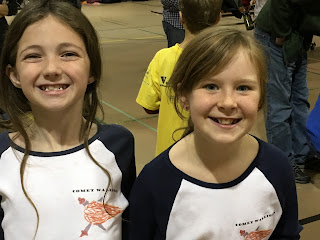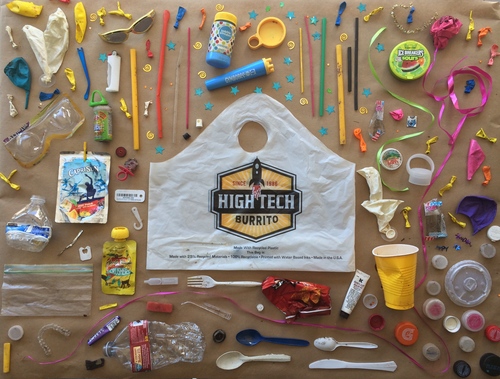Yesterday we spoke with an expert on the electronics industry about e-waste. Olivia emailed
Dr. John Linton, VP of Direct Wafer Process Research and Development at 1366 Technologies to see if he could talk to us about e-waste. He called us at lunch to see how he could help.
The electronics production process, as he described it, consists of first producing silicon wafers. These are made by making very large blocks of silicon metal, which are very expensive to make, and then sawing them up into thin slices. The process of sawing up the silicon into wafers wastes almost half of the silicon as sawdust which gets thrown away.
Once the wafers are made they are treated with special metals including indium, which give the silicon the special properties it needs to work in phones, computers, and other electronics. Another metal used a lot in electronics is cadmium, which is used in batteries. The problem with these metals is that, although they allow us to make amazing electronics, when those electronics end up in landfills the metal can leak out and pollute rivers and streams, groundwater, and other parts of the environment. The metals, even in small amounts, can be very bad for your health. There are laws regulating the use of cadmium in electronics, but there are none for indium which is just as dangerous.
When we asked if he thought there were problems we could work on in e-waste he suggested three:
1) Find a way to save and re-use the silicon sawdust that represents half of all the silicon produced.
2) Apply some science to the classification of metals used in electronics to see which metals should be more carefully controlled and which shouldn't.
3) Find a way to get used electronics into the hand of people who could use them instead of putting them in landfills.
The interview and his email are below (and the secret word for this week is Maren):
Interview with Dr. John Linton, VP of Wafer Process R&D, 1366
Technologies
10/13/2015
Dr. John Linton: Hello.
Is Olivia there?
Olivia: This is
Olivia. I’m sitting here with the Comets
Robotics team. Thanks for calling. We wanted to talk to you today about e-waste
and had some questions that we hoped you could answer.
Dr. John Linton: All right.
I’ll do my best.
Nick: What do you
do?
Dr. John Linton: I work for a company that produces silicon
wafers for solar panels. Right now the
silicon wafer is the most expensive part of the panel. I’m working on a new way of making these solar
wafers that will allow them to be half the cost of normal solar wafers.
Olivia: OK, so
are there any waste problems with that?
Dr. John Linton: Well, one of the waste problems that we’re
tackling is that when you make a solar wafer the first thing you do is make an
enormous block of silicon. It’s about 1
meter on a side. And then you take what
is called a wire saw to saw it into smaller blocks. And then you take that wire saw and saw the
blocks into smaller wafers. And every
time you cut this block to make it smaller you generate sawdust of silicon, and
you have to throw all of that sawdust away, which is waste. So the method I’m working on requires no saws
and no sawdust. And so that’s one of the
ways that we’re tackling the waste problem.
Olivia: OK. Are there any other opportunities in the
e-waste department?
Dr. John Linton: There are lots of opportunities if you
thought about different ways that heavy metal wastes are generated in the
electronics industry, and thought of ways to effectively separate and recycle
those heavy metals.
Olivia: OK
Dr. John Linton: Those heavy metals could be in batteries,
they could be in electronics like computers and smartphones. Even things as simple as a capacitor in a
smartphone can have a heavy metal called Tantalum in it.
Helen: Hi John,
this is Helen.
Dr. John Linton: Hi, Helen.
Helen: So I have
a question. After you’ve separated these
heavy metals then what would happen to them?
Dr. John Linton: Well, right now heavy metals aren’t often
recycled. They’re left in landfills and
they can contaminate the soil, and then the drinking water.
Nick: How is it
handled?
Dr. John Linton: Well, you have to handle heavy metals like
cadmium, for example, very carefully from the time that it’s mined all the way
through manufacturing of a part, and then disposal of the part. When you make a part with cadmium you have to
show that it’s encapsulated such that if it gets in contact with the soil it
doesn’t contaminate the soil.
Olivia: Why isn’t
it being done already?
Dr. John Linton: Well, because heavy metals make very good
products. People really enjoy their cell
phones and their TVs and batteries, so it’s very difficult to get laws to
prevent these products from being made.
Now there are places where laws have been made requiring that things be
recycled safely. Car batteries, for
example, contain lead, which is a heavy metal, in standard car batteries, and
there is a system in place for safely recycling them.
Olivia: OK
Nick: How could
it be handled better?
Dr. John Linton: OK, well there are laws in place. How could it be handled better? Actually, I think some of these laws don’t
depend enough on science. So I wish
there was more science done to show that some heavy metals are safer than
others, and others are very dangerous. I
wish there was more science done to show which ones are the most important.
Olivia: What’s an
example of one of the laws that are in place already?
Dr. John Linton: Ah!
Well, let’s see. There is a heavy
metal called cadmium, which is dangerous. There’s another heavy metal called indium,
which is also dangerous. But while
cadmium is controlled, indium is not. So
I wish there was a lot more science on all the heavy metals.
Helen: Now, are
the problems with some of those metals caused by these guys having strong lobby
groups? Or is it just that they don’t
feel that it’s important enough.
Dr. John Linton: Sometimes it’s just the lack of science. So there’s this group of heavy metals are
covered by a law called ROHS (Restrictions on Hazardous Substances). It’s a European rule that covers six or eight
heavy metals, and just kind of ignores the rest because it doesn’t have data.
Dr. John Linton: What are you guys going to do with all of
this information? Do you have to do some
kind of a report?
Olivia: We have
to clearly distinguish a piece of trash and find a way to keep it out of
landfills.
Helen: They have
to identify a problem and come up with an innovative solution, or an
improvement on something that’s already being done.
Dr. John Linton: Well if you look a cell phones or something
like that, there are so many cell phones sold, and there are a lot of people
who need cell phones. Maybe there’s a
way to generate, or to get these old cell phones to people who need them
without throwing them away. I know I’ve got a drawer full of three or four old
cell phones that I don’t use any more.
Olivia: Does the
silicon end up in landfills?
Dr. John Linton: Well, silicon is actually a very green
material. The earth is made up of 60%
silicon dioxide, also known as sand, or glass, or other things like that. Silicon is everywhere and makes up part of
our bodies and almost everything you stand on.
It’s actually a pretty safe material.
That’s one of the reasons I really like solar energy and like working in
solar energy. Because we’re using a very
green material to make electricity.
So you asked me about recycling silicon and I started
talking about heavy metals which is a topic near and dear to my heart but is
one that the solar industry doesn’t really have a problem with.
Georgia: Do you
have any ideas of what we could do for a project?
Dr. John Linton: Well, I mentioned in an email to Olivia’s dad
that learning how to recycle the silicon dust, the silicon sawdust from the
solar wafer making industry, was one good idea.
While we were talking on the phone I thought of another idea, which
would be to find a way to separate working electronics, such as cell phones or
old TVs and so on, so that people could still use them. If they’re putting them in landfills maybe
you could find a way to use the phone or the TV. Take them
apart so that the parts could be recycled.
What if there was a way to take an old TV and find a way to take the
glass out and turn it into a window or something?
Helen: Nick has
something he wants to say.
Nick: Thank
you! Thank you for taking the time with
us.
Dr. John Linton: Well you’re welcome! If you’ve got any more questions Olivia’s got
my email address. You can email me any
other questions and I’ll answer them if I can
.
All: THANK YOU!
Helen: I have a
question. How’s Maren?
Dr. John Linton: Maren is doing great! She’s really enjoying kindergarten.
Helen: Glad to hear it. Well thanks so much for talking with us.
All: Thanks!
Dr. John Linton: OK you guys.
Good luck and let me know if you have any other questions.
Email from Dr. Linton on project ideas:
Regarding research
topics, here is an area that occurred to me right away, because it is a problem
for our competitors. A lot of energy goes into making silicon, a very
interesting process from sand to Si. Solar manufacturers then melt it, and
crystallize it very slowly (2 weeks) so that as it solidifies, it excludes any
impurities. That is a lot more time and energy. Then they saw it up to make
6"x6" wafers, losing about half of it to "sawdust". The
saws they use are wire saws, and they use some kind of grit to make them work.
because this grit ends up mixed with the nice pure silicon, they throw it
all away. in other words, half of the energy they used to make it is wasted.
Our process makes
wafers one at a time, by putting a cold mold into a hot silicon bath.
No waste.
But it would be
interesting to explore the standard process, showing how Si is made from the
sand, and how much energy is wasted by throwing the sawdust away. And maybe
they could do some settling experiments or something to see how easy/hard it is
to separate. If you could separate it, you could put it back into the process.
But it must be hard, because they don't.
Let me know if that
sounds interesting, i may have some background material that could help Olivia
and her team.











